ART TAIPEI is entering its 30th year in 2023. As the oldest art fair in the Asia-Pacific region that has been held without pause through its three-decade history, it has elevated as an indicator and the spiritual leader in Taiwan’s art industry due to its longstanding presence; for the Asia-Pacific region, it was an important part of the market trend and focal point for international observation of Asia. However, as the times evolved, the Asia-Pacific region has become home to a number of important art fairs, turning the region into a heated battleground for art fairs. What are the differences between these art fairs and ART TAIPE? Through this article, we will take stock of several important art fairs in the Asia-Pacific region, and then review ART TAIPEI’s unique position.
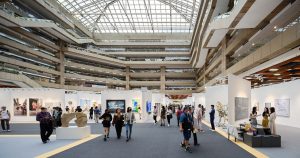
A view of ART TAIPEI (photograph courtesy of ART TAIPEI)
The individualistic styles of freely developing art fairs pioneered by exhibition companies.
This fierce competition between art fairs began in the 2010s when China came to be a huge art market that the world was competing for. Art Basel HK, organized by the Swiss MCH Group, took the lead in 2013 by acquiring the five-year-old Art HK, and Hong Kong soon turned into the staging area for art galleries around the world to enter Asia; this was quickly followed by Shanghai and Beijing, which established their own large-scale art fairs. Backed by more than half a century of experience in operating art fairs and long-term research on the industry, MCH supported galleries participating in Art Basel HK by assisting them in selecting works for display. The exhibition incorporated elements from the rich history of European and American art and humanities. They aimed to strike a balance between experimental and sales-oriented artworks. These fairs seldom featured works from a single artistic trend or aesthetic. Instead, they often showcased the contrasts and contemplation generated by a variety of themes, which contributed to the long-term success of the events.
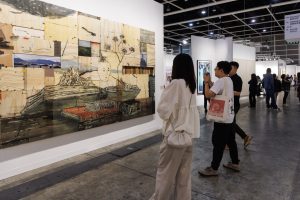
A view of 2023 Art Basel HK (photograph courtesy of Art Basel HK)
In comparison to the single platform created by MCH in Hong Kong, in 2019, the UK-based Art Assembly launched the Taipei Dangdai Art Fair, marking the group's first foray into the Asia-Pacific region. The Art Assembly took "introducing the world's most contemporary artworks to Asia" as its primary approach, and brought more mainstream European and American art to the Taiwanese art scene; at the same time, Taipei Dangdai, with its sponsor UBS Group, joined hand to develop VIP services and parties, taking advantage of elite social networks to enhance the vibrancy of their events. Using the Taipei model as the template, The Art Assembly later reorganized the fairs and proceeded to launch five new ones in the Asia-Pacific region, covering Singapore, Sydney, Tokyo, New Delhi, and Shanghai. Among them, the Singapore event is the one that garners the most attention from art professionals in the Asia-Pacific region.
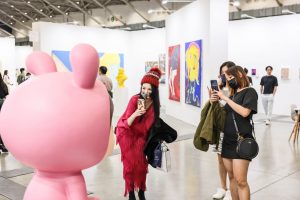
A view of 2023 Taipei Dangdai - Art & Ideas (photograph courtesy of Taipei Dangdai - Art & Ideas)
The Shanghai and Singapore experiences in promoting art fairs by collaborating with the government.
Founded in 2011, Art Stage Singapore was an art fair based on the background of the cultural and economic policies launched by the Singaporean government around the year 2000. Le Free Port (formerly known as Singapore Freeport) in Singapore, established next to Changi Airport, is mainly engaged in art trading. Christie's Fine Art Storage Services (CFASS), a subsidiary of Christie's Auction Group, has its base there. After the city's old art fair Art Stage came to a stop in 2019, The Art Assembly relaunched it in 2023 under the name of ART SG. The new event was jointly sponsored by UBS Group and the Singapore Tourism Board policy alliance to promote Singapore art week. With the collaboration between the public sector and private enterprises, it was hoped that Singapore could be converted into the art capital of ASEAN countries.
Meanwhile, ART021 and West Bund Art & Design, which appeared around the same time as Art Basel HK, were both fairs based in Shanghai. Both were scheduled to be held in early November, but the market position they took up were distinctively different. ART021 is a privately-run expo, where the exhibitors focus more on developing the local market and attracting mainland Chinese collectors; West Bund is established with the support of the government, and the exhibitors focus more on an international orientation. At the same time, because of the support of the Shanghai Municipal People’s Government, the collector base was broader, and the works they collected tended to be more orientated toward a professional/institutional level. Due to being held at the same time and with the geographical advantages they enjoyed, they often served as crucial stops for collectors in the Chinese-speaking community when planning their fair visit itineraries. Both the government and private organizations were proactive in organizing a large number of art activities during the events to attract art enthusiasts.
Attempts at International Art Discourse, from the Korean Government-Backed KIAF to Frieze Seoul.
Art fairs in Korea were founded much earlier on compared to other Asian art fairs, as the Galleries Association of Korea held its first fair in 1978, and launched the first Seoul Art Fair in 1981, both showing the Korean government’s ambition and ability to execute their plans on the art and culture front. In 1998, the South Korean government announced its goal of forming a culturally focused nation, with a clear emphasis on recognizing art and culture as vital industries. In 2003, the Galleries Association of Korea organized Korea International Art Fair (Kiaf), and the exhibitors were mostly composed of local Korean and Asian galleries, but there was also a special "international art" goal. Thus, every year, based on market trends or national diplomatic needs, KIAF would select a country or region as its theme, and invite exhibitors from there to attend the fair.
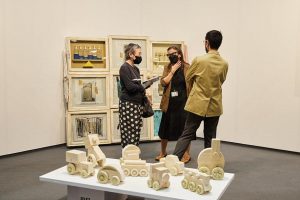
The Drawing Room, Frieze Seoul 2022 (Photo by Lets Studio. Courtesy Lets Studio and Frieze)
In 2022, Frieze Art Fair from the U.K. joined forces with KIAF to create Seoul Art Week with the support of the South Korea’s Ministry of Culture, Sports and Tourism. Frieze Art Fair was created by the art magazine Frieze, and has become an internationally renowned art fair brand in recent years. Similar to the magazine, the fair's curatorial approach emphasizes academic and experimental artworks, aiming to pique the interest of discerning collectors in the Asian region. Additionally, they seek to establish a mutually beneficial partnership with the pre-existing KIAF SEOUL, where the two fairs can complement each other." The South Korean art scene also felt the competitive pressure from Frieze in attracting collectors and aimed to connect with a broader international audience through this opportunity." Furthermore, they aimed to turn Korean art into a powerful asset in their cultural export strategy, drawing inspiration from the success of the Korean music, film, and television industries. This effort is unmistakably reflected in the significant increase in the number of Korean galleries participating in Taiwanese exhibitions in recent years.
Several major cities in the Asia-Pacific region have already begun the next wave of territorial competition. Building on the basis of maintaining local collectors, "Who will attract more international exhibitors and overseas collectors?" has already posed a challenge that none can avoid. In addition to Hong Kong, which maintains a stable connection with the international community, the governments of Seoul and Singapore have successively proposed industrial policies in response to the situation. ART TAIPEI, relying on its solid foundation accumulated over the past thirty years, is also beginning to integrate resources from all walks of life in Taiwan. It is hoped that both internally and externally, it can foster a solid backing for Taiwan’s art galleries to connect with the international community.
Asia Pacific’s Unique Gallery Association and ART TAIPEI.
After sorting out the history and current situation of art fairs in the Asia-Pacific region, we return to Taiwan. It cannot be denied that in the contemporary context, there is a positive correlation between the strength of artworks and the strength of the country it originated from. For European and American countries that have long possessed the influence in culture, finance, politics and even world history, they have also long held a dominant share in the art market. With the economic competition within the Asia-Pacific region and the influence of internal policies in the region, the ecology of Taiwan's art industry is rather unique. In 2023 alone, there are around 15 art fairs that have or are soon to take place, each with its own style and demands.
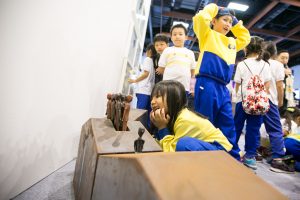
A view of Art Education Day (photograph courtesy of ART TAIPEI)
Different from art fairs under the control by private groups, ART TAIPEI is organized by Taiwan Art Gallery Association (TAGA), which is a corporate body comprised of various local galleries. It encourages local galleries in Taiwan to participate in the exhibition, while consolidating connections with the local art industry, and strives to create a communication platform for various sectors. In addition to focusing on sales, it also combines government resource by organizing events such as the “MIT-Taiwan Young Artists Connection with the World" special exhibition (sponsored by the Ministry of Culture to provide award-winning artists with access to the gallery industry and entry into the art market), and "Art Education Day" (sponsored by the Ministry of Education to promote art education, allowing students to get in touch with international art and get to know Taiwanese artists) and other diverse activities, allowing art to take root across generations, and using the various sectors to drive the fair.
In addition, ART TAIPEI also actively maintains its connections with galleries in the Asia-Pacific region. The proportion of international galleries participating in the fair has remained stable over the past decade, with the exception of special circumstances such as the pandemic. In particular, galleries from Japan and South Korea have strategically operated in the Taiwan market for many years, and their styles have also brought no small amount of influence on the Taiwanese art scene.
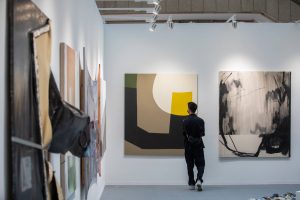
A view of ART TAIPEI 2022 (photograph courtesy of ART TAIPEI)
Conclusion
Having lived through the changes in the art market in the Asia-Pacific region, ART TAIPEI has always maintained its unique value and position: it strengthens gallery collaborations, local connections, cultural education, and support for local young artists, all of which demonstrate the resilience and social involvement of Taiwan's art industry. In early 2020, the world was struck by the COVID-19 pandemic, leading to a sharp decline in the number of arts and cultural exhibitions and performances. Taiwan was fortunately in staving off the effects of the pandemic for the most part, and ART TAIPEI became one of the few large-scale art fairs around the world that could be held as scheduled during the pandemic, and will continue to maintain its momentum in the post-pandemic era. Furthermore, with Taiwanese artworks now able to resonate with the world and garner recognition and resources from overseas collectors, ART TAIPEI is actively integrating various resources to enhance its appeal and draw larger crowds. By continually enhancing its content, ART TAIPEI aims to attract more art enthusiasts from home and abroad to visit the exhibition.
